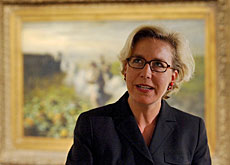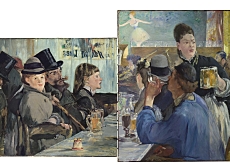Art collectors flock to thriving Swiss market

Switzerland is building up an impressive reputation as one of the world's most important markets for art dealing, the head of Sotheby's in Zurich tells swissinfo.
Claudia Steinfels places Switzerland as the fourth largest market globally, close on the heels of France, and says Art Basel is the biggest and best modern art fair in the world.
The financial centre of Zurich has also profited from an art boom with several new galleries opening in recent years to cash in on the growing international trade.
The Swiss are among the most discerning art collectors, building up impressive “living” art collections in their homes, according to Steinfels.
swissinfo: What is the state of the art market internationally?
Claudia Steinfels: It is currently booming due to the fact that we have a broader interest from countries including Russia, India, South Korea and China that were not active before. This allows us to create new sales, for example in the Chinese contemporary market.
The boom is clearly linked to economic conditions and there is certainly more money around at the moment. New money tends to want to buy art for prestige and for recognition.
It used to be that the art market went through cycles: three fat years followed by seven lean years – but this is no longer the case.
If you have a good eye, you can currently buy art pieces at very reasonable prices that could become good investments.
swissinfo: And in Switzerland?
C.S.: Switzerland is now the fourth largest art market in the world behind the United States [New York accounts for around 55% of total global sales volume], Britain and France. It overtook Japan at the beginning of the 1990s and is now not far behind France which has a much bigger population.
After London, Zurich is number two on the continent [of Europe] for art sales.
swissinfo: Why has Switzerland become a more important art market?
C.S.: Much of the momentum has come from the Art Basel fair that started 30 years ago and has now become the top modern art fair in the world. It is the place to buy and sell, get information about the market place, find out what type of art is “in” and what is going on in the art world.
Art Basel clearly makes an impact by bringing so many collectors to Switzerland. Many arrive and stay overnight in Zurich and visit galleries there, which is why so many have opened up in recent years.
Collectors come to Switzerland with the financial means and they are in the mood to spend.
swissinfo: Does the Swiss tax regime help art sales?
C.S.: We are experiencing strong sales in Switzerland because of its central location, stability and because it is a very liberal country with no extra taxes for art. I don’t know of any important export restrictions and that puts Switzerland at a great advantage to other countries such as Italy.
When someone buys a piece of art over 50 years old in Italy you need an export licence from Rome. If you buy a brooch in Milan from the 1950s for €2,000 you need an export licence that costs another €100-200 – and this is simply not working.
And, unlike in the European Union, descendents of an artist do not get a cut when art pieces are sold on [a common law known as droit de suite], and there is no capital gains tax to pay.
swissinfo: How do the Swiss view art?
C.S.: Switzerland is a poor country in art compared with neighbours Italy and France, but the Swiss compensate for this by buying. Swiss collectors are very passionate about art and are extremely alert about what is going on, particularly in the modern art scene.
People do not think there is much going on behind the doors of Swiss houses because they are not always open. But, in fact, many have the most wonderful paintings on their walls.
Private art collections in Switzerland are living because collectors are willing to part with items they feel do not fit in any more. You only need to look at the collection of [former industrialist and art collector] Oskar Reinhart [housed in Winterthur] to see how much thought and passion the Swiss put into their collections.
swissinfo: How important is modern art in the international market right now?
C.S.: Twenty years ago the Old Masters were the focus of every auction house and then the Impressionists became more important.
Nowadays we are seeing a surge of interest in modern and contemporary art and the genre is poised to take over that role as market leader.
swissinfo-interview: Matthew Allen
An auction of Swiss art held by Sotheby’s in Zurich in May fetched a world record SFr4,948,000 for Ferdinand Hodler’s “Am Genfersee”.
This beat the previous record of SFr4,800,000 set in November last year for “Eiger, Mönch und Jungfrau über dem Nebelmeer” by the same Swiss artist.
The total money raised from sales at the May auction was SFr14,706,300, smashing the SFr11,587,600 target set the previous November.
The Sotheby’s auction house held its first sale of art in 1744 and set up its first office in Switzerland in Zurich in 1969.
Swiss industrialist Oskar Reinhart (1885-1965) built up an impressive collection of art in his lifetime that can now be viewed by the public at his former private residence called “Am Römerholz” in Winterthur.

In compliance with the JTI standards
More: SWI swissinfo.ch certified by the Journalism Trust Initiative


You can find an overview of ongoing debates with our journalists here. Please join us!
If you want to start a conversation about a topic raised in this article or want to report factual errors, email us at english@swissinfo.ch.